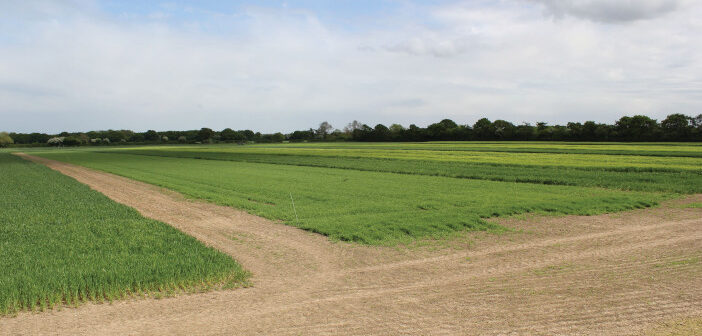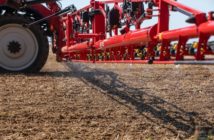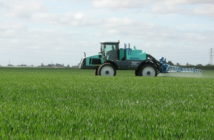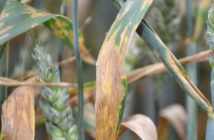At North Hall Farm, Appleton Roebuck, devoting 23ha of productive but demanding land with serious Italian ryegrass problems to a national centre for sustainably managing this troublesome weed has given the Vale of York family business a huge confidence boost.
Working with Agrii’s experienced R&D team from Stow Longa near Huntingdon – with more than 21 seasons of pioneering farmscale black-grass management behind them – Roger and Virginia Mills and their son Mark are exploring a wide range of integrated cultural controls alongside the most effective chemistry to deal with triple R-resistant ryegrass.
Three years into the project, huge variations in weed control are being highlighted across a wide range of tillage regimes, rotations, crop and variety choices. And, in typical Stow Longa style, the work is already extending to finding better ways of managing the health and vitality of soils with some of the highest silt contents in the country.
Problematic ryegrass
“When we first got involved with the Agrii work, our overwhelming need was to deal with the resistant ryegrass that is so problematic locally,” explains self-confessed ‘wheat junky’ Roger, who is now growing almost twice as much spring barley as wheat across the 325ha business.
“Too many people will tell you it’s just like black-grass. But, from bitter experience, we know it’s far more serious. It spreads much more rapidly. It’s very much more competitive. It keeps germinating right into the spring. And the physical pressure it puts on cereals can easily destroy them completely, making a promising crop fit for nothing more than silage.
“We’ve learnt an unbelievable amount over the past three years. And not just about ryegrass either. The research is utterly transforming the way we think about and manage our ground, reinvigorating my enthusiasm for the future.
“We made the change to minimum tillage almost 20 years ago and brought in much better crops as a result,” he recalls. “But we failed to appreciate how much harder our ground had been getting to work over the years and how much more horsepower, diesel and metal we were having to use.
“Like many, I suspect, the change was too gradual for us to notice. We are getting decent wheat yields, our drains continued to run well and we still had plenty of worms. So, we just put every challenging season down to the weather and got on with it.
“Armed with their spades, full soil analyses and practical soil health understanding, Colin Lloyd and Steve Corbett soon worked with our agronomist, Rob Daniel, to put us right. They have opened our eyes to how much more we could make from our cropping by changing our approach. Which we have been doing as fast as we can, and making great progress as a result.”
Finding solutions
Among other things, regularly soil loosening with wide-winged legs on their Sumo Versadrill Plus as they drilled had helped the Mills family grow good 10t/ ha wheat crops when the conditions were right. Having explored what was actually happening in depth in setting-up the trial site, though, they realised their establishment approach was waking-up ryegrass seed at just the wrong time. It was also encouraging silt to run through the profile to pan out, leading to very tight soils without the vertical linkages essential for the best rooting, worm activity and drainage.
Appreciating this, the group designed the 4.5ha of initial along tried and tested Stow Longa lines to explore a range of cultivation, cropping and rotational approaches. Despite two incredibly wet winters forcing major changes in planting plans, they clearly established that, just like black-grass, ploughing could be a good reset, reducing weed populations approaching 2,000 plants/m2 to virtually zero.
“Our first year’s work with spring crops – because we just couldn’t drill anything in the winter of 2019 – also showed straw raking and direct drilling was worse for both weed populations and crop performance than a single pass with a set of discs,” Colin Lloyd reports. “Uncropped strips between the spring oats, triticale and spring barley we grew under each regime underlined both this and the extra competitive value of the cropping.
“Of the three crops, oats proved the most and triticale the least effective in reducing ryegrass populations ahead of the six different varieties of winter barley, five winter wheats and three spring barleys we drilled the following season.
Ploughing
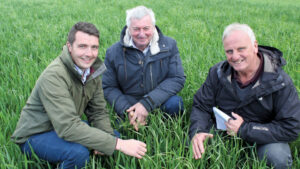
Roger Mills his agronomist, Rob Daniel (left) and Colin Lloyd (right) check some of the Old Appleton trial plots
“True to black-grass form, ploughing the plough just brought-up the weed seed again while ploughing previously min-tilled ground led to the lowest ryegrass counts,” he says. “Wheats on the ploughed block yielded reasonably at an average of 10.5t/ha but they were the only ones we were able to harvest in 2021. Sky high ryegrass levels in the other wheat blocks meant they had to be foraged.
“The ploughed block gave us reasonable winter and spring barley yields too – around 9.0t/ha and 7.5t/ha respectively. While we were able to harvest them on the other blocks, at near enough 5t/ha in both cases the barleys here were very disappointing. It just underlines how problematic ryegrass can be.”
Even though rotational ploughing stood out for doing by far the best ryegrass control job, the team quickly appreciated they needed to look far beyond it for the most sustainable solution at North Hall Farm. This was mainly because initial soil analyses revealed a silt content of 49%, together with organic matters at little more than 2.5% and disappointing levels of biological activity.
Since then the focus on the trial site and across the Mills’ wider Olde Appleton Farms business has, first and foremost, been on building organic matter and soil health. At the same time, their min-till and drilling approach has been adapted to reduce pressure on the ground, and they are exploring a far wider range of rotational options.
Trial continuing
The original tillage and rotation trial is continuing for a third year with winter wheats and winter barleys drilled with a trailed Amazone Cayena on demonstration rather than the family’s original Versadrill and spring barleys with their newly acquired mounted Weaving Sabre Tine, all following 20t/ha autumn applications of sewage cake.
Alongside this and also following sewage sludge application, light discing with a Lemken Rubin and low disturbance lifting with a He-Va Stealth are large grain and straw yield blocks of September-sown KWS Hawking two-row and SY Armadillo hybrid winter barleys and mid-October sown RGT Silversurfer wheat drilled with the Cayena.
There is also a substantial replicated small plot wheat herbicide trial and an area of spring barley comparing autumn with spring low disturbance soil lifting.
Even more interesting, perhaps, are 12 hectares of combine-width, fully costed 1ha trial blocks now dedicated to both building organic matter and managing ryegrass. These are comparing different approaches right up to margin level.
“Our long-term organic matter building trials revolve around spring barley this season ahead of winter wheat planned for 2023,” says Steve Corbett. “We established eight blocks of Skyway barley in late March in what has become the preferred strategy here – Sabre Tine drilling after autumn discing with the Rubin and low disturbance Stealth lifting.
“Four of the blocks followed a cover crop mix of vetch, phacelia, buckwheat and crimson clover sown from a seeder on the Rubin in early September, with four noncover cropped blocks alongside them for comparison. Across these, we have paired straw management strategies – chopped or baled – and organic manuring approaches – sewage cake or FYM.
“On a further two blocks of late March-drilled Skyway we have spun on a three-way white clover blend after drilling to give a semipermanent cover into which we can drill the following wheat.
“Finally, we have two blocks of Westerwolds ryegrass established in September 2020, one cut three times last season and the other cut once then drilled with a cover in June. Both were direct drilled with Graham winter wheat using the Cayena in late September after lifting with the Stealth.
“These trials are providing us with the best practical intelligence we can get on improving the health and workability of these difficult silt soils while controlling the ryegrass scourge,” points out Rob Daniel.
“However good it may be at controlling grassweeds, ploughing can create serious problems silt panning here if we are not very careful. So, we have to look to other ways of skinning this particular cat.“
Spring cropping
Spring cropping is clearly important, which is why Roger and Mark have so much of it in the ground at the moment despite their long-standing preference for winter wheat.
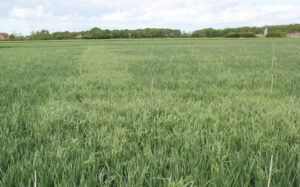
Ryegrass infestations stand out a mile in a major Old Appleton herbicide screen
“Delaying winter wheat drilling can help too but later drilling can actually make things worse if it leads to a less competitive crop. Delaying spring drilling until after ryegrass’ normal mid-late March spring flush is probably a better bet for us, providing we have crops and varieties that can take it.
“The Stow Longa team are really showing us the value of competitive winter crops like hybrid barley and rye – providing they can be sown early enough – and competitive wheat varieties like RGT Silversurfer and Graham. They are also actively pointing us towards the most competitive spring choices.
“However, the key to the most competitive crops has to be the best establishment and the healthiest, most resilient soils. These are consequently the focus of so much of our trial work and farm improvement efforts.”
Thoroughly enthused by the trial team’s objective assessments and fresh thinking, Roger and Mark Mills have wasted no time in applying a host of initial learnings to their entire business. As well as a wholesale change in their tillage and establishment regime over the past two years, they have almost doubled the amount of sewage cake applied from 2,300 tonnes last year to 4,000 tonnes across the farm this year.
Cover cropping
They have moved from zero to more than 120ha of cover cropping in a single season. And, having seen the dramatic difference it made to both the soil and ryegrass populations in just a year, are keen to ‘fight fire with fire’ using Westerwolds ryegrass more widely.
“It’s a huge learning process and we are very far from having all the answers yet,” insists Roger. “As far as we can see, there’s no killer solution. It’s more a matter of putting a multitude of things together in the best possible way.
“Switching to a much lighter and more flexible tillage approach is, however, really helping; especially on our turning headlands. The 6m Sabre Tine is particularly valuable here wherever the conditions are too wet for the deadweight of a trailed drill. With a front mounted tank it weighs much less than our old 4m Versadrill and reduces the wheelings too.
“Separating the subsoiling from our other operations and employing a 4in wing rather than our previous 14in one means we are using the least possible metal at depth now and only where it’s needed. As well as reducing silt panning, we don’t wake-up nearly so much ryegrass at drilling, either.
“We’d love to use FYM but we just can’t get enough of it around here, so sewage cake is our soil health improver of choice. We are looking to marry this with less soil movement, cover cropping and the best crop residue retention to reverse the decline in soil biology and workability as quickly as we can while stabilising the silt in the profile.
“It is working economically too,” he adds. “What we are saving in reducing our cultivations each year pays for our cover cropping. And we should be giving our tractors a longer working life as well as cutting their maintenance bills.
“It will take us a while to get things like cover cropping spot-on for our soils and the fact that we are seldom able to establish them before September up here. But that’s the great joy of having well-run, farm scale trials on our own ground. We can really find out what works then apply it as rapidly as we can across our business.”
Read more:
Read about a farmer-led project to combat grassweeds here
Read agronomy news stories here

